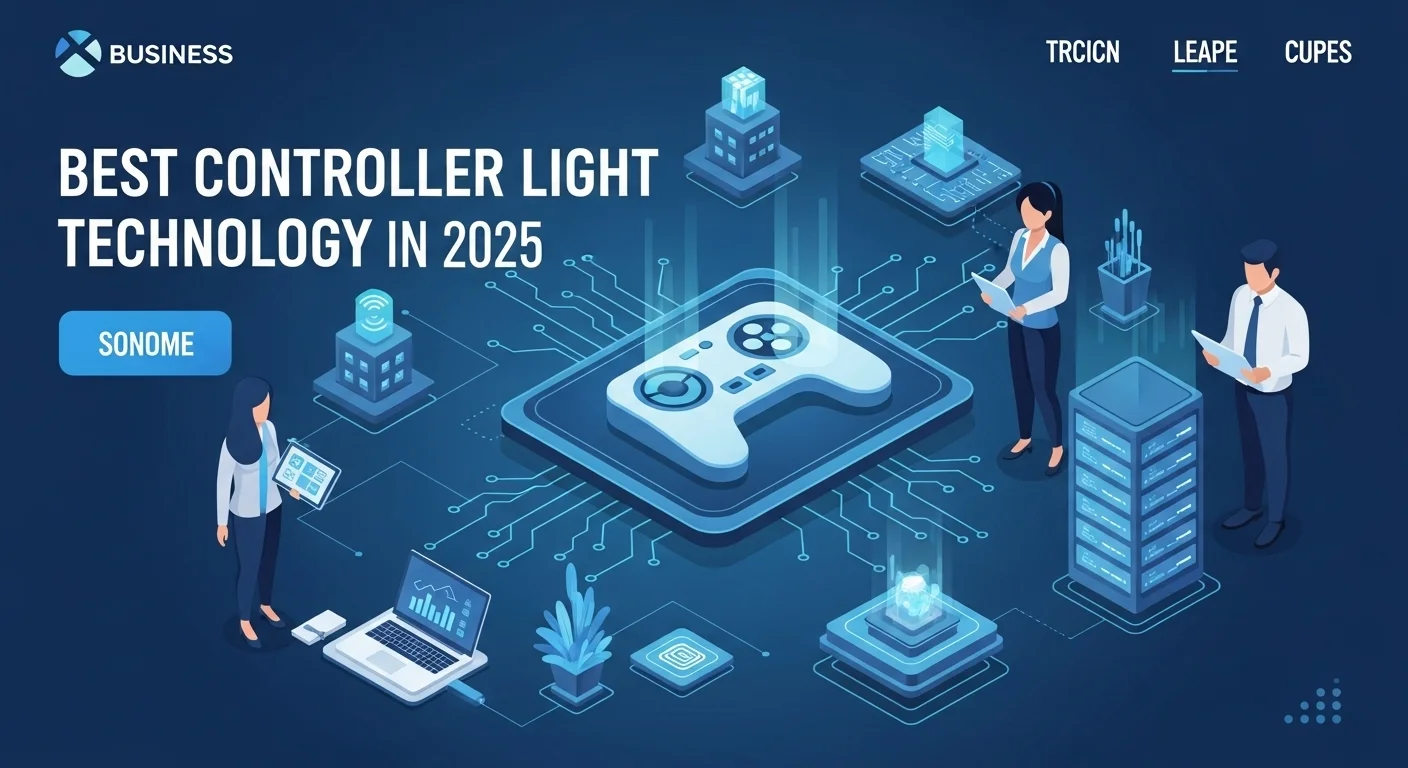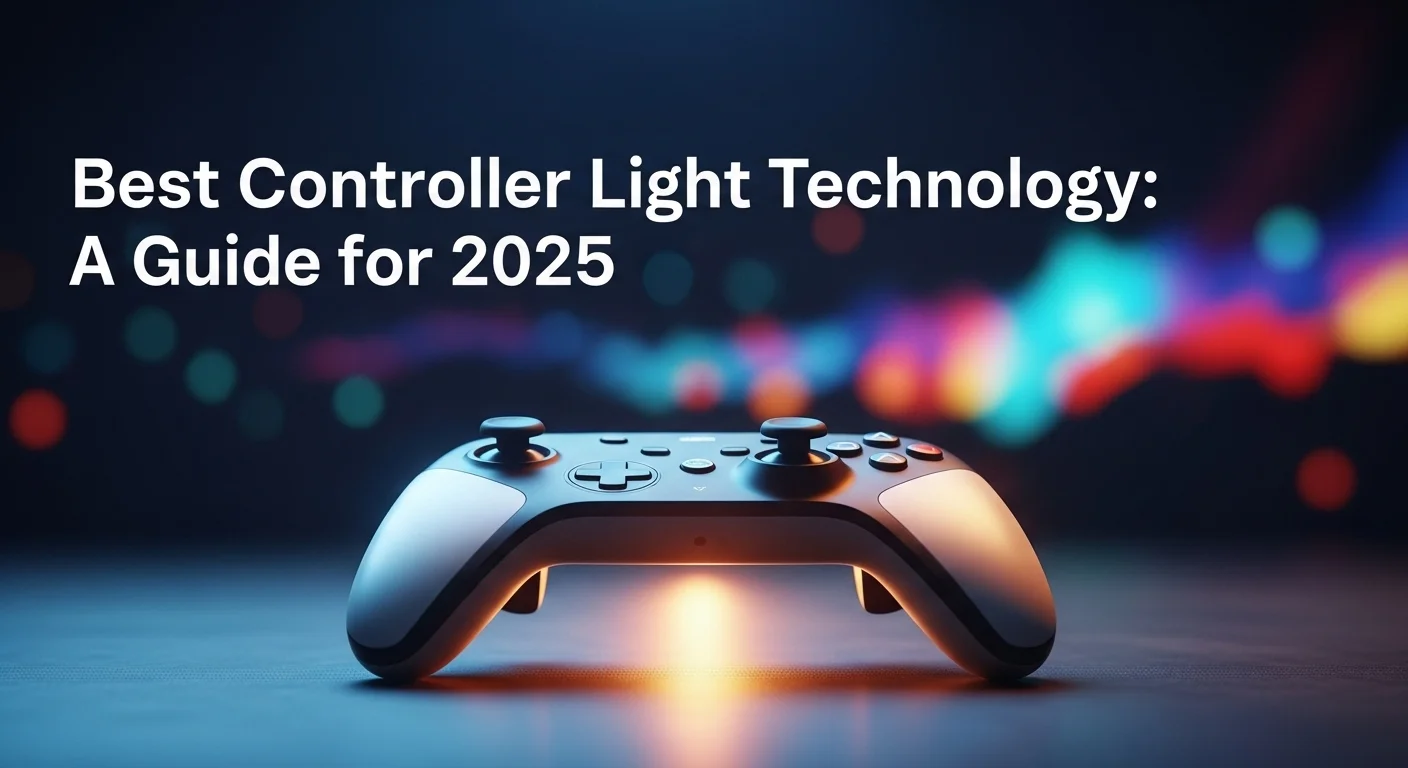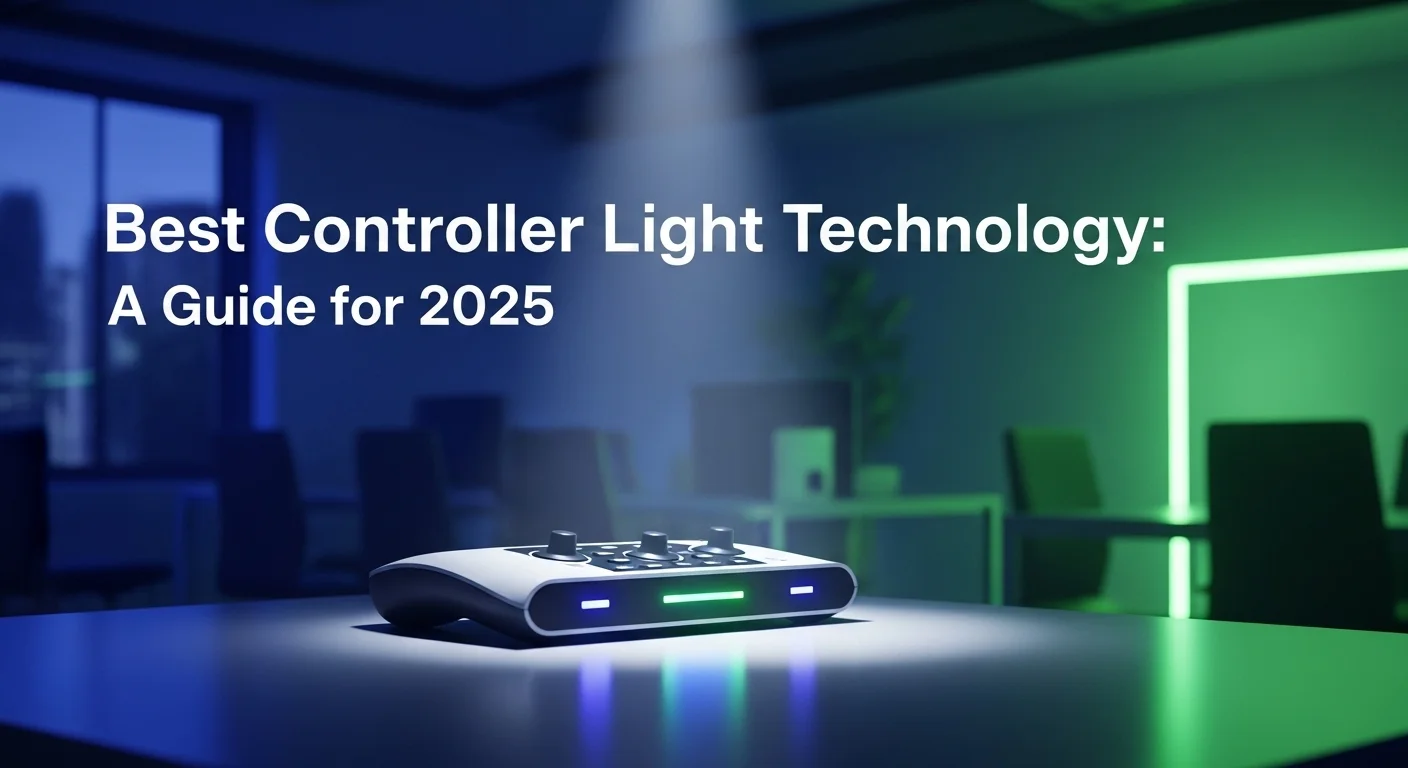Choosing the Best Lighting Control System: An Expert's Guide for 2025

Executive Summary
For as long as I've been working with smart technology, I've seen that nothing transforms a space quite like light. But it's not just about flipping a switch anymore. A 'lighting control system' is the brain behind your lights, the conductor of an orchestra of illumination. It’s what allows you to craft the perfect mood, boost your productivity, and even make your home more secure. For businesses, this means serious energy savings and happier employees. For homeowners like you and me, it's about convenience and creating a space that truly feels like your own. In this guide, I'll cut through the jargon and share my experience to help you make your home more secure, explore the options, and find the perfect lighting control system for 2025 and beyond.
Table of Contents
- What Exactly Is a Lighting Control System?
- From Simple Dimmers to Intelligent Brains
- The Tech That Makes It All Work: Protocols, AI, and Security
- Why Smart Lighting is a Game-Changer for Businesses
- The Real Magic: What a Great System Does for Your Home
What Exactly Is a Lighting Control System?
When we talk about the 'best controller light' or a lighting control system, we're not talking about a single gadget. Think of it as the central nervous system for all the illumination in a building. It’s the combination of smart switches, sensors, and software that work together to decide when, where, and how your lights operate. In my years of setting these systems up, I've seen them evolve from simple dimmers to truly intelligent networks that can transform a sterile room into a warm, inviting, and responsive space. This technology is the bedrock of any modern smart home or automated business, impacting everything from your electricity bill and productivity to your mood and security.
From Simple Dimmers to Intelligent Brains
I remember when installing a dimmer switch felt incredibly high-tech. It gave us our first real taste of controlling a room's ambiance. Then came simple timers, which were great for making it look like someone was home. But the real revolution happened when lighting went digital. Protocols like DALI became the standard for commercial buildings, giving every light its own digital address. For homes, wireless languages like Zigbee and Z-Wave made smart lighting accessible to everyone. Today, we're in an even more exciting era where Artificial Intelligence (AI) is being woven in. The best systems I work with now can actually learn your habits, adjust to the daylight outside, and even anticipate your needs. They're no longer just about lighting; they communicate with your heating, security, and speakers to create one seamless, automated experience.
The Tech That Makes It All Work: Protocols, AI, and Security
The engine of any lighting system is its communication protocol—the language the devices use to speak to each other. It’s a crucial choice.
- Wired Systems (like DALI & KNX): These are the workhorses of the commercial world. They're incredibly reliable because they're physically connected. For a new office building or a high-end home construction, I almost always recommend a wired backbone for its rock-solid performance.
- Wireless Systems (like Zigbee, Wi-Fi, & Bluetooth): This is what most people have in their homes, and for good reason. They are easy to install in an existing house and flexible. They create a 'mesh' network where your smart bulbs and switches can pass messages along, making the network stronger with every device you add.
- The Universal Translator (Matter Protocol): The most exciting development in years is Matter. Backed by giants like Apple, Google, and Amazon, Matter is designed to be a universal language for smart devices. This is a huge win for you, because it means you'll be able to buy a device from one brand and have it work perfectly with another. It’s making the dream of a truly connected, hassle-free smart home a reality.
Artificial Intelligence (AI) is what gives the system its 'smarts.' It's not just about turning lights on when you enter a room. AI can analyze occupancy patterns in an office to save energy, or gently wake you up by simulating a natural sunrise, which is fantastic for your internal body clock. This is the kind of personalization that defines a top-tier system.
Of course, with all this connection comes the need for cybersecurity. Think of your smart lighting system as a new digital door to your home or business network. You need to make sure it’s locked. A secure system uses strong encryption and authentication to keep intruders out. Reputable manufacturers now build security in from the start, because a hacked light could be a gateway to much bigger problems.
Why Smart Lighting is a Game-Changer for Businesses
For any business, installing a quality lighting control system isn't a cost; it's an investment that pays for itself. I've seen the benefits firsthand across different industries:
- In Offices: The energy savings are immediate and substantial, often cutting lighting costs by over 50%. But it goes deeper. We can now tune the light to mimic the natural progression of the sun, which studies show reduces eye strain and boosts employee focus and well-being. A happy, healthy team is a productive team.
- In Stores and Hotels: Light is a powerful sales tool. We can program dynamic scenes to highlight new products or create a specific brand atmosphere. In a hotel, giving a guest the ability to select a 'Relax' or 'Work' lighting scene in their room with one touch is a luxury experience that they remember.
- In Warehouses and Factories: Here, it's all about safety and efficiency. A smart system ensures every area is perfectly lit for the task, reducing accidents. It can also light up only the aisles that are currently in use, slashing energy waste in massive spaces.
Plus, these systems generate valuable data, allowing facility managers to see exactly where energy is being used and proactively manage maintenance.
The Real Magic: What a Great System Does for Your Home
This is where the fun really begins. For homeowners, a great lighting control system is about weaving convenience and personality into the fabric of your home.
- Effortless Convenience: Being able to say, 'Hey Google, turn on Movie Night,' and watch the main lights dim, the lamps soften, and the shades close is a little piece of everyday magic. A 'Goodnight' button that turns off every single light in the house is a feature my clients say they can't live without once they have it.
- A Sense of Security: Smart lighting is a fantastic deterrent. When you’re on vacation, the system can play back your normal lighting patterns, creating a convincing 'lived-in' look. I often integrate systems with cameras, so if motion is detected outside, the landscape lights instantly jump to full brightness.
- Real Energy Savings: Dimmers alone save electricity. Add in sensors that turn lights off when you leave a room and scheduling that ensures lights aren't left on all night, and the savings on your utility bill really add up.
- Total Personalization: This is my favorite part. With color-tunable and color-changing bulbs, you can paint your rooms with light. You can have a vibrant, energetic scene for a party, a calm, warm glow for dinner, or program your lights to support your natural sleep cycle. It’s about making your home's environment work for you, not the other way around.

A Practical Guide to Choosing Your System
Picking the right lighting control technology can feel overwhelming, but it really boils down to understanding a few key concepts. After years of designing these systems, I can tell you the best choice always starts with your specific space and goals. Let's break down the technical options and then look at some of the brands I trust.
Technical Methods: Wired vs. Wireless and Centralized vs. Decentralized
The architecture of your system is the first big decision. It's the foundation everything else is built on.
Wired Lighting Control Systems
In my experience with large commercial projects and high-end homes, wired systems are the undisputed champions of reliability. They use dedicated, low-voltage cables to connect everything.
- DALI (Digital Addressable Lighting Interface): In the commercial world, DALI is the gold standard for a reason. Think of it as giving every single light fixture its own voice. You can control each light individually or group them in software, all without touching the physical wiring. It can even tell you if a bulb has burned out. It’s powerful, flexible, and built for professional environments.
- KNX: This is more than just lighting; it's a complete building automation protocol. KNX can manage your lights, heating, security, and blinds on one unified network. It's a beast of a system that offers incredible integration for a truly smart building.
The bottom line on wired: It's incredibly robust and secure. The downside is the installation cost and complexity, making it best suited for new construction or major renovations.
Wireless Lighting Control Systems
For most homes, and even many business retrofits, wireless is where the magic happens. It's less mess, less fuss, and the technology has become incredibly reliable.
- Zigbee & Z-Wave: These are the two biggest names in wireless home automation. They are low-power, so they don't interfere with your Wi-Fi, and they create a 'mesh network.' This means your devices talk to each other, passing the signal along. The more devices you add, the stronger your network becomes. Philips Hue, a system I recommend often, is a great example of Zigbee in action.
- Wi-Fi: Many entry-level smart bulbs connect directly to your home's Wi-Fi. It's simple because you don't need an extra hub. The trade-off is that adding too many Wi-Fi devices can clog up your network, and their performance depends entirely on how good your Wi-Fi signal is in that specific spot.
- Bluetooth Mesh: This works similarly to Zigbee, creating a web of communicating devices. It's very efficient and is becoming more common, especially for setting up devices.
The bottom line on wireless: It’s easy to install, affordable, and flexible. You just need to be mindful of potential interference and ensure your network is secure.
Centralized vs. Decentralized Architecture
This is about where the 'brain' of your system lives.
- Centralized: Here, a main processor or hub (from brands like Lutron, Control4, or Crestron) runs the entire show. All your keypads and sensors report back to this central brain, which then tells the lights what to do. This is the approach for powerful, whole-home systems with complex scenes and integrations.
- Decentralized: In this model, the intelligence is spread out. A smart switch or bulb has its own mini-computer inside to store its settings. Systems like Lutron Caséta or most Wi-Fi bulbs work this way. They're simpler, and if your internet goes down, the switch on the wall still works.
Business Techniques for Implementation
For a business, a successful rollout is a strategic process.
- Define Your 'Why': Before you even look at a product, be clear on your goal. Is it pure energy savings? Improving the employee experience? Creating a 'wow' factor for customers? Knowing this will guide every other decision.
- Calculate the ROI: To get budget approval, you need to show the return on investment. Tally up the projected energy savings, reduced maintenance costs from long-lasting LEDs, and even potential productivity boosts. A solid plan presents the system as a smart financial move.
- Plan for the Future: Don't box yourself in. Choose a system that can grow with you. I always push for systems based on open standards like Matter, because it ensures you won't be stuck with an obsolete, single-vendor ecosystem in five years.
- Integrate Everything: The real power is unlocked when your lighting talks to other building systems. Linking it to the HVAC can lower your cooling bill. Connecting it to the security system can create a safer environment during an emergency.
Resources and Comparisons: Finding the Best System for You
The market is full of great options. If clients ask me where to start, my answer depends on their end goal.
Professionally Installed Integrated Systems
- Lutron: They are the undisputed leader in lighting control. Caséta is their DIY-friendly line and the system I recommend to friends for its reliability. RA3 and HomeWorks are their professional-grade systems for whole-home control, offering incredible power and bulletproof performance. They just work.
- Crestron: This is the 'sky's the limit' option. Crestron provides a completely bespoke automation solution. If you can dream it, a good Crestron programmer can make it happen. It's the definition of a custom, high-end smart home.
- Control4 & Savant: These are other giants in the pro-install space. Control4 is known for its ability to play nicely with a massive universe of third-party products. Savant is often praised for its beautiful and intuitive user interface, especially for users in the Apple ecosystem.
High-End System at a Glance
| Brand | Best For | Key Strength | Integration Style |
|---|---|---|---|
| Lutron | Rock-Solid Lighting Control | Reliability, Quality, Scalability | Best-in-class lighting, great with others |
| Crestron | Ultimate Customization | Infinite Possibilities, Full Ecosystem | Powerful, but prefers its own ecosystem |
| Control4 | Broad Device Integration | Works with Almost Everything | The ultimate third-party integrator |
| Savant | Premium User Experience | Beautiful Interface, Apple-Friendly | Focus on a seamless, luxury feel |
Consumer-Friendly Systems
- Philips Hue: The most recognizable name in the space, and for good reason. Hue offers a vast selection of bulbs and a user-friendly app. The Hue Bridge is the heart of the system and makes it very reliable.
- Wiz: Also from the makers of Hue, Wiz is a great hub-free, Wi-Fi-based alternative. It's generally more affordable and a fantastic starting point for simple smart lighting.
- Govee: Govee has carved out a niche with fun, vibrant, and affordable products, especially their light strips. They offer creative features like syncing your lights to music or what's on your TV screen.
- Wyze: If budget is your primary concern, Wyze offers some of the most affordable smart bulbs and plugs on the market. They make smart lighting accessible to absolutely everyone.
Ultimately, the best system is the one that meets your needs. For a single room, a few Wi-Fi bulbs might be perfect. For a reliable, whole-home experience that will last for decades, a professionally installed system is the way to go. And with Matter becoming more common, mixing and matching the best devices from all these brands is about to get a whole lot easier.

My Pro Tips for Mastering Your Smart Lighting
Getting a smart lighting system installed is just the beginning. The real joy comes from fine-tuning it to perfectly match your lifestyle. Over the years, I've gathered a set of best practices and tricks that can elevate your system from just 'smart' to truly intelligent. Here are my tips for getting the most out of your technology experience.
My Golden Rules for a Flawless Smart Lighting Setup
- Design with Layers, Not Just Lights: Before you buy anything, think about how you use a room. This is the key to a great lighting experience. I always design with three layers:
- Ambient Light: This is your general, room-filling light, like from recessed ceiling fixtures.
- Task Light: This is focused light for a specific purpose, like under-cabinet lights for chopping vegetables or a good lamp for reading.
- Accent Light: This is the fun stuff—light that highlights a piece of art, a plant, or a cool architectural feature.
- Treat Your Network Like a Fortress: Your lighting system's performance depends on a healthy network. For wireless setups, a strong mesh Wi-Fi system is your best friend. But more importantly, take security seriously. Always change the default passwords, use two-factor authentication, and keep your firmware updated. If you can, I highly recommend putting all your smart home devices on a separate guest network to wall them off from your computers and personal data.
- Invest in the Future with Interoperability: Your home will evolve, and your tech should too. Choose a system that can grow with you. More importantly, I urge all my clients to prioritize systems that support open standards. Right now, that means looking for the Matter logo. Buying Matter-certified devices is the single best way to ensure that the system you build today won't be obsolete tomorrow.
- Never Underestimate a Good Wall Switch: Apps and voice control are amazing, but sometimes you just want to tap a button on the wall. A physical, smart keypad is often the fastest and most intuitive way to control your lights, especially for guests. The best systems offer a seamless experience across all control points—app, voice, and a beautifully engraved keypad on the wall.
Advanced Strategies to Unlock Your System's Potential
Ready to go beyond the basics? Here are some of the strategies I use to create truly amazing experiences.
- Sync Your Lights to Your Body Clock (Human-Centric Lighting): This is, without a doubt, one of the biggest wellness benefits of smart lighting. I switched my own home office lighting to a circadian rhythm schedule, and the difference was night and day—literally. The system automatically provides cool, bright light during the day to help with focus and then gradually shifts to a warm, soft glow in the evening to help me wind down. It’s a feature available in systems from Philips Hue to high-end Ketra, and it's a game-changer.
- Let Your Phone Do the Work with Geofencing: Use your phone's location as a trigger. I have my system set to automatically turn on the porch and entryway lights when I pull into the driveway. It’s a small thing, but never having to fumble for keys in the dark feels like luxury. It also ensures all the lights turn off when the last person leaves, saving energy effortlessly.
- Become a Scene-Creating Master: Move beyond 'on/off' and create moods. Every system allows for scenes, so get creative! Some of my client favorites include:
- 'Movie Night': Dims overhead lights to 10%, turns off distracting lamps, and adds a soft backlight to the TV to reduce eye strain.
- 'Sunday Morning': A soft, warm light in the kitchen and living room, just bright enough to read the paper and sip your coffee.
- 'Focus Mode': A clean, bright, cool-toned light (around 4000K) in the office to help with concentration during a work session.
- Use Sensors for True, Invisible Automation: The best system is one you don't even have to think about. That's where sensors come in:
- Occupancy/Vacancy Sensors: These are perfect for places you pass through, like laundry rooms, closets, and hallways. The light turns on when you enter and off a minute after you leave. Simple and brilliant.
- Daylight Sensors: For rooms with big windows, these sensors measure the amount of natural light and dim your bulbs accordingly. It saves energy without you ever noticing.
- Contact Sensors: I love putting these on pantry doors. The light pops on the second you open it and turns off when you close it. It’s a simple, satisfying automation.
Helpful Tools and Resources
For those who want to dive even deeper, there are some great resources available.
- Management Dashboards: Professional systems from Lutron, Crestron, and others provide powerful software that lets you see energy usage, run diagnostics, and manage the entire system from a single interface.
- APIs for Custom Projects: For the true tech enthusiast, many systems have an API, which lets you or a developer write custom code to make the lighting system do practically anything you can imagine.
- Professional Expertise: For a larger project, don't hesitate to bring in a professional integrator. They live and breathe this stuff and can design and execute a flawless system tailored specifically to you.
A Resource I Trust: If you really want to get ahead of the curve, I highly recommend checking out the Connectivity Standards Alliance, the people behind the Matter protocol. Their website is a goldmine of information on the standard that is shaping the future of all smart home technology. You can explore it at csa-iot.org.
By putting these strategies into practice, your lighting control system will become a seamless and valuable part of your home or business, enhancing your life in ways you might not have even imagined.
Expert Reviews & Testimonials
Sarah Johnson, Business Owner ⭐⭐⭐
The guide on lighting control systems gave a good overview, but as a business owner, I was hoping for more case studies or practical examples of ROI. It's accurate, just a bit theoretical for my needs.
Mike Chen, IT Consultant ⭐⭐⭐⭐
This was a really helpful article on lighting control. It clarified a lot for me as an IT consultant who deals with network integration. Some of the protocol details could have been a bit simpler, but overall, a solid read.
Emma Davis, Tech Expert ⭐⭐⭐⭐⭐
An absolutely brilliant article! As a tech specialist, I found this guide on lighting control to be incredibly comprehensive and well-explained. It's a huge help for my work, and I understood every part perfectly. Five stars!



